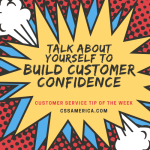
Years ago, a mining company received numerous formal complaints about the noise from its operations. The complaints primarily came from one nearby neighborhood. That neighborhood was the location where the mining company had to build a small above-ground structure to support the operations.
The community was interested in finding ways to address the noise. One of the ideas that residents came up with was to put a hedge around the structure. The company said that the noise wasn’t coming from the structure; it was actually coming from the mining field, but the company decided to do what the residents requested.
So, they built a hedge around this structure that was so tall and dense that residents couldn’t see the object.
Eventually, the formal complaints completely stopped.
Kudos to the residents for coming up with an idea to address a company problem, and kudos to the company for doing what the residents suggested and not arguing the point.
What’s the takeaway? Many issues and solutions are more about perception than reality. Seeing something makes you associate it with other things. The structure made you think of the noise, which made you think negatively about the company. Remove the visual reminder (the structure), and the noise was the only reminder about…the noise – which people got used to over time.
I experience this personally every day. I live near a fire station, but rarely do I notice the sirens unless I see the flashing lights.
When you’re trying to deliver a great customer experience, one way you do so is to eliminate the pain points in the customer journey. But another way is to avoid reminding the customer about the pain. If long waits or old facilities or excessive paperwork are challenges to the service experience, work to improve those – but also avoid shining a light on them.
Address reality AND perception. Don’t publicize pain points.
Signup for FREE Tips! Contact Us More Resources for You Visit Our Home Page























